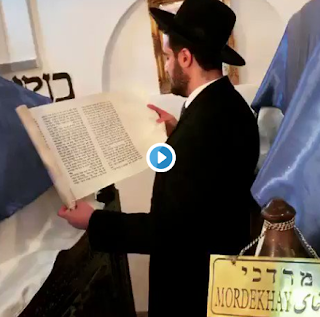
To project an image recalling Cyrus the Great, liberator of the Jews of Persia, its ruler Reza Shah pressed the Iranian Jewish community to buy the site of Esther and Mordechai’s tombs at Hamadan in the 1970s, Chen Malul writing in the Jerusalem Post reveals.
In a letter sent by the director-general of the Department of Archaeology and Public Education, Mr. Abdolali Pourmand, to Mr. Lotfollah Hay, the representative of Iran’s Jews in parliament, Pourmand clarified that the office of National Education would assist the Iranian Jewish community in purchasing the tomb and the land surrounding it from the Bazargani Bank, its owner at the time. The purchase would be funded by the selling of tickets to the site.
Rabbi Garami of Tehran reads the Megillah at the tomb of Esther and Mordechai during the festival of Purim in 2020. Click here to see video clip.
In the correspondence, the sense of urgency expressed by the regime’s representative is clear. Pourmand pressed the Jewish community to reply to the initiative – with an affirmative response being the obvious preference – as the department’s queries had so far gone unanswered.
In addition to the tomb-purchasing initiative, the Jewish community also planned to build a vocational school named after Cyrus the Great, as well as a hospital. There were even plans for a Hebrew-Persian dictionary and an exhibition dedicated to Cyrus’ achievements which would focus on the topic of Torah-based human rights, in various languages.
It is unclear how much of all this actually came into being. The archives, however, do include evidence that the purchase of the grounds of the tomb was indeed completed, with final approval arriving on January 18th, 1970.
It appears that the land was transferred into the hands of the community – though it is difficult to say for certain as the documentation ceases at this stage. A letter certifying that the grounds of the tomb were purchased; this is also the latest document found in the correspondence, from January 18th, 1970.
The honeymoon period between the Jews of Iran and the state authorities would come to a quick, cruel end with the Islamic Revolution of 1979 and the rise to power of Ayatollah Ruhollah Khomeini. This event also saw the last Shah of Iran, “The New Cyrus”, flee the country for the United States.
Since then, the tomb of Esther and Mordechai has been the focus of bitter dispute. In 2011, regime-supporting students rioted outside the compound and called for its removal from the list of protected Iranian heritage sites – as a response to their claims that Israel was seeking to destroy the al-Aqsa Mosque.
Their efforts were something of a success, with the sign noting the tomb’s status as a site of pilgrimage being removed. From time to time, protesters from across Iran issue threats to destroy the tomb and replace it with a Palestinian consulate. A recent incident of this kind occurred in February. So far however, the site remains intact, with only Jews allowed entrance to the tomb enclosure.

Leave a Reply